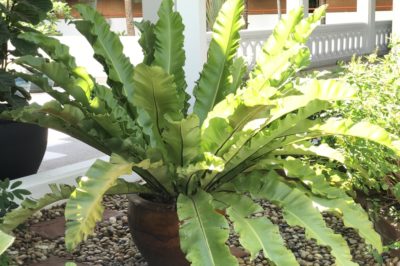The Right Environment
Bird’s Nest Fern is a tropical jungle plant, native to rainforests. As you might surmise, this means it needs:
- Bright indirect light
- High humidity
- Warm temperatures both day and night
- Moist but not soggy soil
- Rich soil that drains well.
The plant also prefers to be under-potted and naturally grows in cramped conditions.
Problem: Pale Leaves
Normally, Bird’s Nest Fern fronds are a bright apple green. The leaf surface should be shiny. If the fronds start to look pale, the first thing to do is check the light conditions. Too much bright light damages the leaves and makes them look pale instead of bright apple green. An east- or north-facing window is best, with full sun only in early morning.
Problem: Plant Doesn’t Grow
There are two possible explanations here. The first is inadequate fertilizer. Bird’s Nest Ferns do better with frequent small feedings. A liquid fertilizer diluted to one-half or one-quarter strength is a good choice in the active growing season – feed once a week. Too much sunlight can also hamper growth. If that’s the problem, fronds will be pale; decrease light exposure.
Problem: Poor Growth, Root Rot
Although Bird’s Nest Fern needs moist soil soggy, waterlogged soil promotes root rot. It can handle an occasional dry period, so if the roots have an odor or look brown and mushy, stop watering for a few days. When you resume, water every other day. Make sure the container drains well. If drainage is the problem, repot in a mix of two-thirds perlite to one part peat moss.
Problem: Brown Fronds
This jungle plant cannot handle low temperatures – meaning anything much below 60°F (16°C). It prefers a temperature range of 70°F (27°C) to 80°F (21°C). If the fronds begin to brown along the edges or the whole frond turns brown, check the temperature. Too little water is another possibility. Soil should be evenly moist but not soggy. Mist plants twice daily to increase humidity.
Problems: Insects
Any time your Bird’s Nest Fern doesn’t seem to be doing well, examine it carefully for signs of insects. Those brown dots on the leaf undersides are spores, which is normal. Cottony masses are mealy bugs, while foliar nematodes cause translucent spots on the leaf tops that turn black. Scale isn’t obvious, but can stunt the plant. Ask an expert to confirm identification and recommend treatment.
